Pabitra Mitra
Modeling Ranking Properties with In-Context Learning
May 23, 2025Abstract:While standard IR models are mainly designed to optimize relevance, real-world search often needs to balance additional objectives such as diversity and fairness. These objectives depend on inter-document interactions and are commonly addressed using post-hoc heuristics or supervised learning methods, which require task-specific training for each ranking scenario and dataset. In this work, we propose an in-context learning (ICL) approach that eliminates the need for such training. Instead, our method relies on a small number of example rankings that demonstrate the desired trade-offs between objectives for past queries similar to the current input. We evaluate our approach on four IR test collections to investigate multiple auxiliary objectives: group fairness (TREC Fairness), polarity diversity (Touch\'e), and topical diversity (TREC Deep Learning 2019/2020). We empirically validate that our method enables control over ranking behavior through demonstration engineering, allowing nuanced behavioral adjustments without explicit optimization.
MorCode: Face Morphing Attack Generation using Generative Codebooks
Oct 10, 2024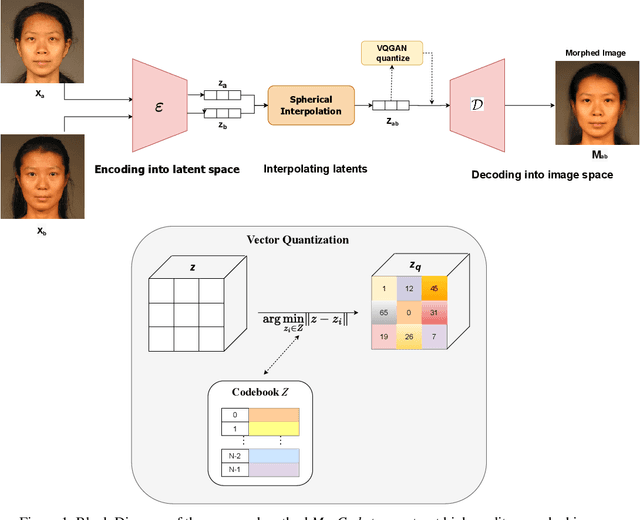
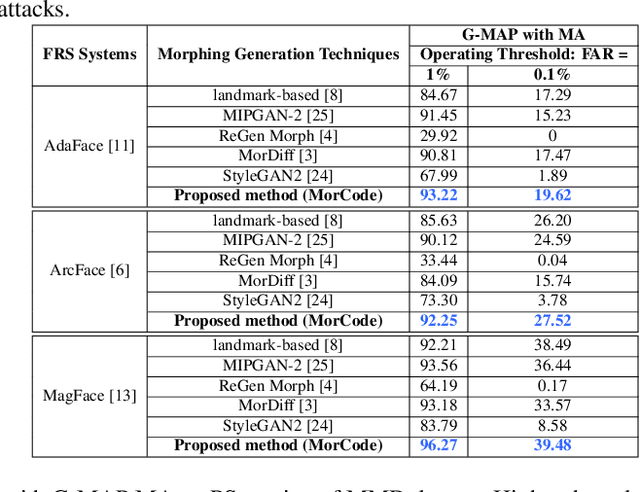
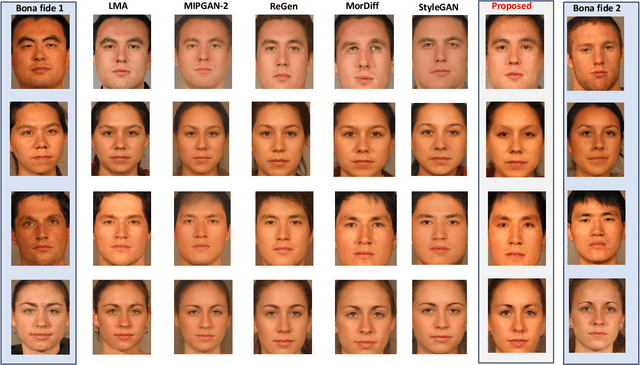
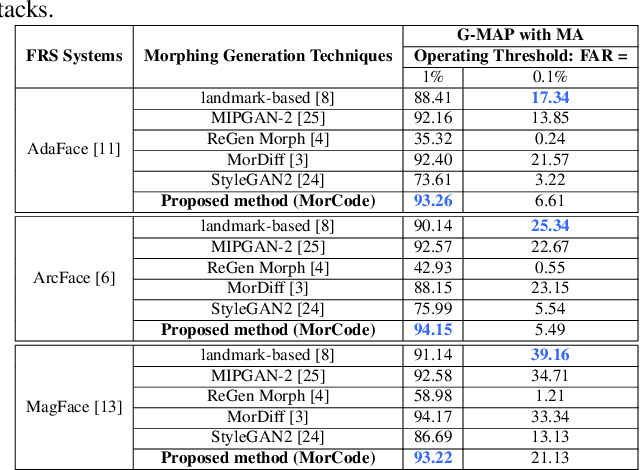
Abstract:Face recognition systems (FRS) can be compromised by face morphing attacks, which blend textural and geometric information from multiple facial images. The rapid evolution of generative AI, especially Generative Adversarial Networks (GAN) or Diffusion models, where encoded images are interpolated to generate high-quality face morphing images. In this work, we present a novel method for the automatic face morphing generation method \textit{MorCode}, which leverages a contemporary encoder-decoder architecture conditioned on codebook learning to generate high-quality morphing images. Extensive experiments were performed on the newly constructed morphing dataset using five state-of-the-art morphing generation techniques using both digital and print-scan data. The attack potential of the proposed morphing generation technique, \textit{MorCode}, was benchmarked using three different face recognition systems. The obtained results indicate the highest attack potential of the proposed \textit{MorCode} when compared with five state-of-the-art morphing generation methods on both digital and print scan data.
Few-shot Pairwise Rank Prompting: An Effective Non-Parametric Retrieval Model
Sep 27, 2024Abstract:A supervised ranking model, despite its advantage of being effective, usually involves complex processing - typically multiple stages of task-specific pre-training and fine-tuning. This has motivated researchers to explore simpler pipelines leveraging large language models (LLMs) that are capable of working in a zero-shot manner. However, since zero-shot inference does not make use of a training set of pairs of queries and their relevant documents, its performance is mostly worse than that of supervised models, which are trained on such example pairs. Motivated by the existing findings that training examples generally improve zero-shot performance, in our work, we explore if this also applies to ranking models. More specifically, given a query and a pair of documents, the preference prediction task is improved by augmenting examples of preferences for similar queries from a training set. Our proposed pairwise few-shot ranker demonstrates consistent improvements over the zero-shot baseline on both in-domain (TREC DL) and out-domain (BEIR subset) retrieval benchmarks. Our method also achieves a close performance to that of a supervised model without requiring any complex training pipeline.
NeuralMultiling: A Novel Neural Architecture Search for Smartphone based Multilingual Speaker Verification
Aug 08, 2024



Abstract:Multilingual speaker verification introduces the challenge of verifying a speaker in multiple languages. Existing systems were built using i-vector/x-vector approaches along with Bi-LSTMs, which were trained to discriminate speakers, irrespective of the language. Instead of exploring the design space manually, we propose a neural architecture search for multilingual speaker verification suitable for mobile devices, called \textbf{NeuralMultiling}. First, our algorithm searches for an optimal operational combination of neural cells with different architectures for normal cells and reduction cells and then derives a CNN model by stacking neural cells. Using the derived architecture, we performed two different studies:1) language agnostic condition and 2) interoperability between languages and devices on the publicly available Multilingual Audio-Visual Smartphone (MAVS) dataset. The experimental results suggest that the derived architecture significantly outperforms the existing Autospeech method by a 5-6\% reduction in the Equal Error Rate (EER) with fewer model parameters.
Straight Through Gumbel Softmax Estimator based Bimodal Neural Architecture Search for Audio-Visual Deepfake Detection
Jun 19, 2024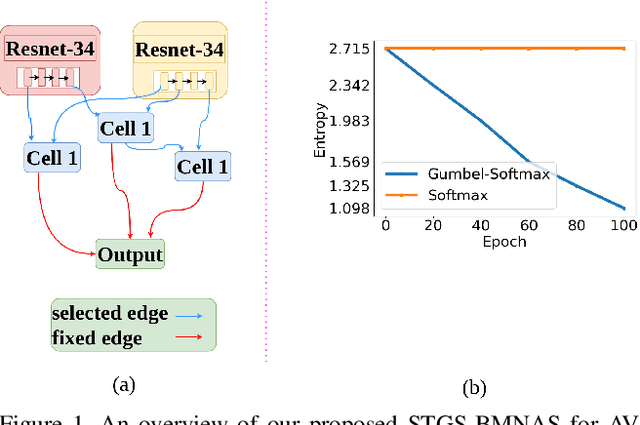
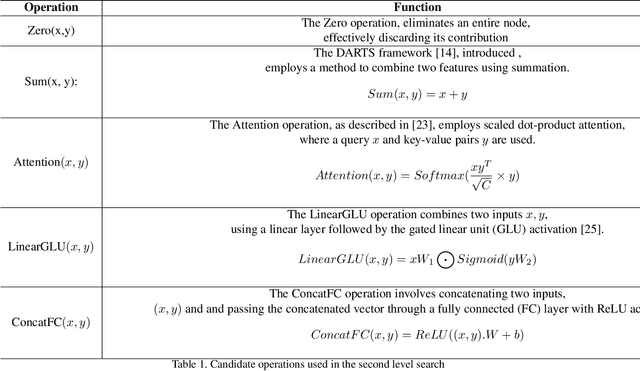

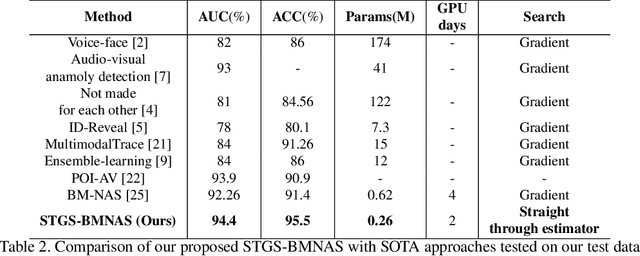
Abstract:Deepfakes are a major security risk for biometric authentication. This technology creates realistic fake videos that can impersonate real people, fooling systems that rely on facial features and voice patterns for identification. Existing multimodal deepfake detectors rely on conventional fusion methods, such as majority rule and ensemble voting, which often struggle to adapt to changing data characteristics and complex patterns. In this paper, we introduce the Straight-through Gumbel-Softmax (STGS) framework, offering a comprehensive approach to search multimodal fusion model architectures. Using a two-level search approach, the framework optimizes the network architecture, parameters, and performance. Initially, crucial features were efficiently identified from backbone networks, whereas within the cell structure, a weighted fusion operation integrated information from various sources. An architecture that maximizes the classification performance is derived by varying parameters such as temperature and sampling time. The experimental results on the FakeAVCeleb and SWAN-DF datasets demonstrated an impressive AUC value 94.4\% achieved with minimal model parameters.
MLSD-GAN -- Generating Strong High Quality Face Morphing Attacks using Latent Semantic Disentanglement
Apr 19, 2024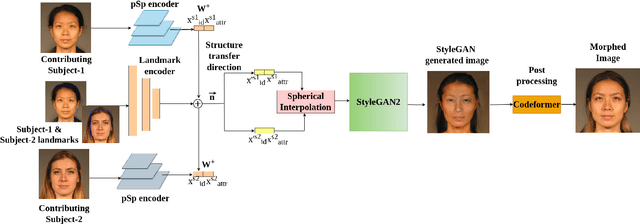

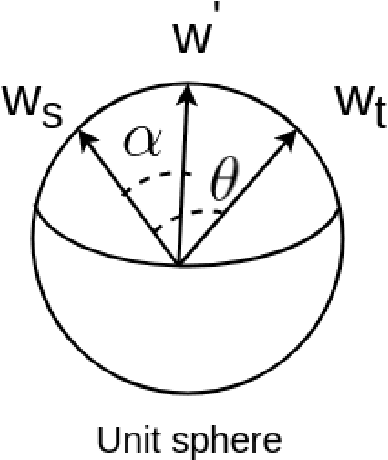
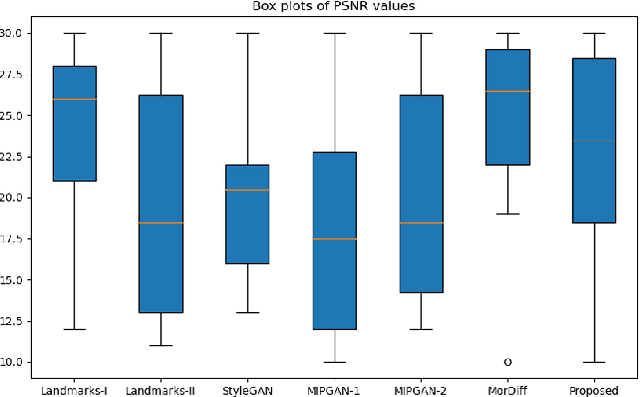
Abstract:Face-morphing attacks are a growing concern for biometric researchers, as they can be used to fool face recognition systems (FRS). These attacks can be generated at the image level (supervised) or representation level (unsupervised). Previous unsupervised morphing attacks have relied on generative adversarial networks (GANs). More recently, researchers have used linear interpolation of StyleGAN-encoded images to generate morphing attacks. In this paper, we propose a new method for generating high-quality morphing attacks using StyleGAN disentanglement. Our approach, called MLSD-GAN, spherically interpolates the disentangled latents to produce realistic and diverse morphing attacks. We evaluate the vulnerability of MLSD-GAN on two deep-learning-based FRS techniques. The results show that MLSD-GAN poses a significant threat to FRS, as it can generate morphing attacks that are highly effective at fooling these systems.
Graph Expansion in Pruned Recurrent Neural Network Layers Preserve Performance
Mar 17, 2024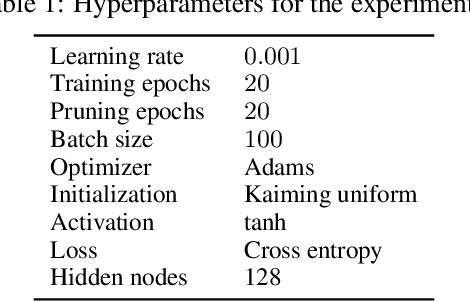
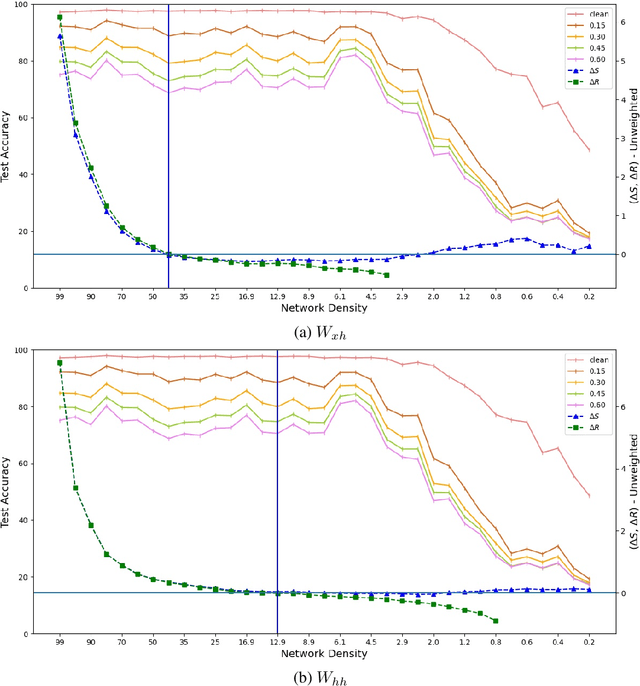
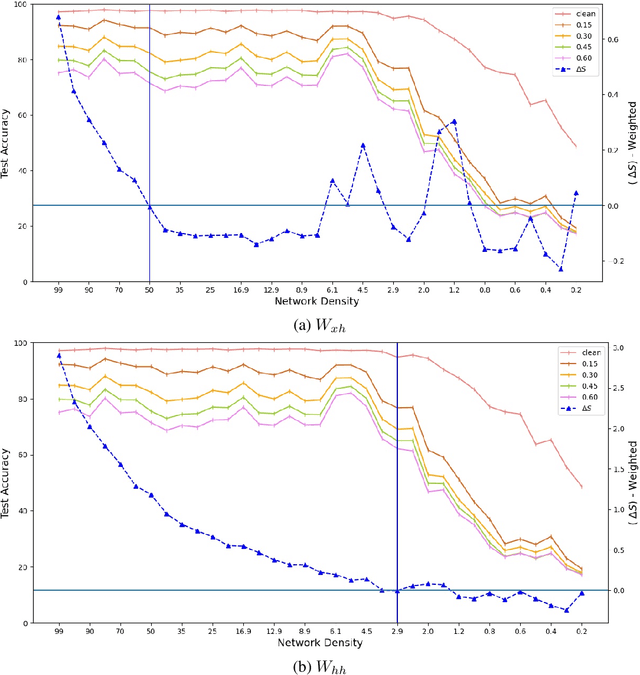
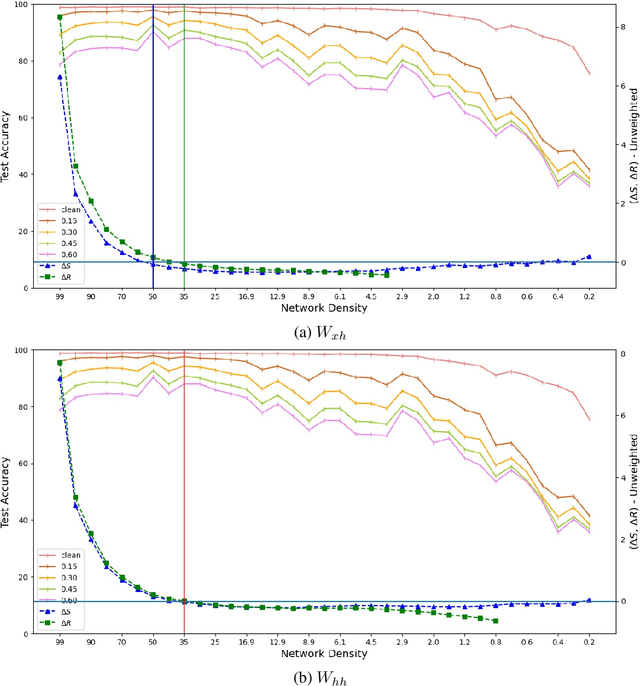
Abstract:Expansion property of a graph refers to its strong connectivity as well as sparseness. It has been reported that deep neural networks can be pruned to a high degree of sparsity while maintaining their performance. Such pruning is essential for performing real time sequence learning tasks using recurrent neural networks in resource constrained platforms. We prune recurrent networks such as RNNs and LSTMs, maintaining a large spectral gap of the underlying graphs and ensuring their layerwise expansion properties. We also study the time unfolded recurrent network graphs in terms of the properties of their bipartite layers. Experimental results for the benchmark sequence MNIST, CIFAR-10, and Google speech command data show that expander graph properties are key to preserving classification accuracy of RNN and LSTM.
Stealing the Invisible: Unveiling Pre-Trained CNN Models through Adversarial Examples and Timing Side-Channels
Feb 19, 2024Abstract:Machine learning, with its myriad applications, has become an integral component of numerous technological systems. A common practice in this domain is the use of transfer learning, where a pre-trained model's architecture, readily available to the public, is fine-tuned to suit specific tasks. As Machine Learning as a Service (MLaaS) platforms increasingly use pre-trained models in their backends, it's crucial to safeguard these architectures and understand their vulnerabilities. In this work, we present an approach based on the observation that the classification patterns of adversarial images can be used as a means to steal the models. Furthermore, the adversarial image classifications in conjunction with timing side channels can lead to a model stealing method. Our approach, designed for typical user-level access in remote MLaaS environments exploits varying misclassifications of adversarial images across different models to fingerprint several renowned Convolutional Neural Network (CNN) and Vision Transformer (ViT) architectures. We utilize the profiling of remote model inference times to reduce the necessary adversarial images, subsequently decreasing the number of queries required. We have presented our results over 27 pre-trained models of different CNN and ViT architectures using CIFAR-10 dataset and demonstrate a high accuracy of 88.8% while keeping the query budget under 20.
Optimizing Odia Braille Literacy: The Influence of Speed on Error Reduction and Enhanced Comprehension
Oct 12, 2023


Abstract:This study aims to conduct an extensive detailed analysis of the Odia Braille reading comprehension among students with visual disability. Specifically, the study explores their reading speed and hand or finger movements. The study also aims to investigate any comprehension difficulties and reading errors they may encounter. Six students from the 9th and 10th grades, aged between 14 and 16, participated in the study. We observed participants hand movements to understand how reading errors were connected to hand movement and identify the students reading difficulties. We also evaluated the participants Odia Braille reading skills, including their reading speed (in words per minute), errors, and comprehension. The average speed of Odia Braille reader is 17.64wpm. According to the study, there was a noticeable correlation between reading speed and reading errors. As reading speed decreased, the number of reading errors tended to increase. Moreover, the study established a link between reduced Braille reading errors and improved reading comprehension. In contrast, the study found that better comprehension was associated with increased reading speed. The researchers concluded with some interesting findings about preferred Braille reading patterns. These findings have important theoretical, developmental, and methodological implications for instruction.
On the Evaluation of User Privacy in Deep Neural Networks using Timing Side Channel
Aug 03, 2022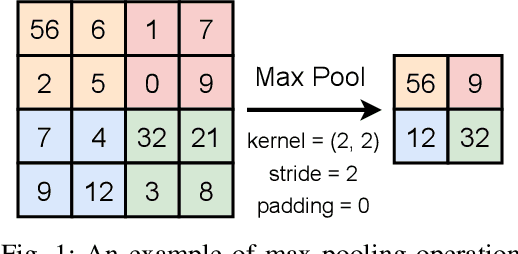
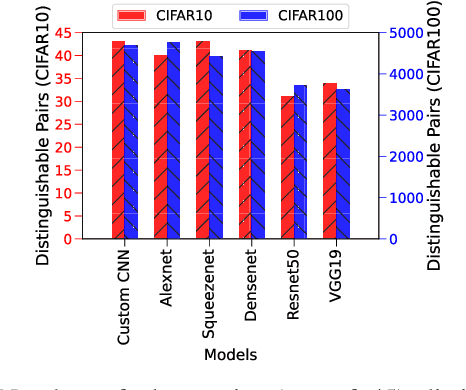
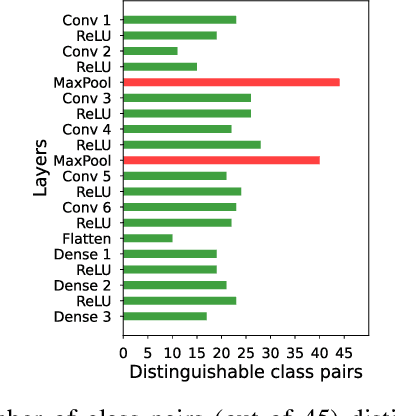
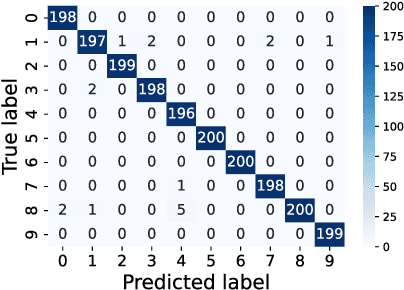
Abstract:Recent Deep Learning (DL) advancements in solving complex real-world tasks have led to its widespread adoption in practical applications. However, this opportunity comes with significant underlying risks, as many of these models rely on privacy-sensitive data for training in a variety of applications, making them an overly-exposed threat surface for privacy violations. Furthermore, the widespread use of cloud-based Machine-Learning-as-a-Service (MLaaS) for its robust infrastructure support has broadened the threat surface to include a variety of remote side-channel attacks. In this paper, we first identify and report a novel data-dependent timing side-channel leakage (termed Class Leakage) in DL implementations originating from non-constant time branching operation in a widely used DL framework PyTorch. We further demonstrate a practical inference-time attack where an adversary with user privilege and hard-label black-box access to an MLaaS can exploit Class Leakage to compromise the privacy of MLaaS users. DL models are vulnerable to Membership Inference Attack (MIA), where an adversary's objective is to deduce whether any particular data has been used while training the model. In this paper, as a separate case study, we demonstrate that a DL model secured with differential privacy (a popular countermeasure against MIA) is still vulnerable to MIA against an adversary exploiting Class Leakage. We develop an easy-to-implement countermeasure by making a constant-time branching operation that alleviates the Class Leakage and also aids in mitigating MIA. We have chosen two standard benchmarking image classification datasets, CIFAR-10 and CIFAR-100 to train five state-of-the-art pre-trained DL models, over two different computing environments having Intel Xeon and Intel i7 processors to validate our approach.
 Add to Chrome
Add to Chrome Add to Firefox
Add to Firefox Add to Edge
Add to Edge